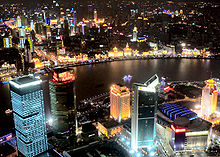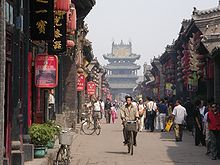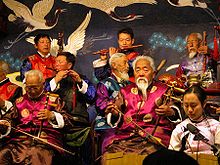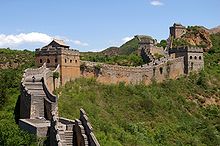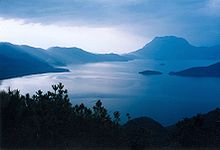- Tourism in China
-
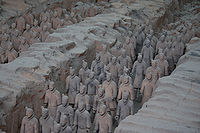 An example of cultural site: the Terracotta Army in Xian.
An example of cultural site: the Terracotta Army in Xian.
Tourism in China has greatly expanded over the last few decades since the beginning of reform and opening. The emergence of a newly rich middle class and an easing of restrictions on movement by the Chinese authorities are both fueling this travel boom. China has become one of the world's most-watched and hottest inbound and outbound tourist markets. The world is on the cusp of a sustained Chinese tourism boom.[1]
China is the world's third most visited country in the world. The number of overseas tourists was 55.98 million in 2010.[2] Foreign exchange income was 45.8 billion U.S. dollars, the world's fourth largest in 2010. The number of domestic tourist visits totaled 1.61 billion, with a total income of 777.1 billion yuan.[1]
According to the WTO, in 2020, China will become the largest tourist country and the fourth largest for overseas travel. In terms of total outbound travel spending, China is currently ranked fifth and is expected to be the fastest growing in the world from 2006 to 2015, jumping into the number two slot for total travel spending by 2015.[1]
China's tourism revenue reached $185 billion in 2009.[3]
Contents
History
Between 1949 and 1974, the People's Republic was closed to all but selected foreign visitors. In the late 1970s, when Deng Xiaoping decided to promote tourism vigorously as a means of earning foreign exchange, China started to develop its tourist industry. Major hotel construction programs greatly increased the number of hotels and guest houses, more historic and scenic spots were renovated and opened to tourists, and professional guides and other service personnel were trained.
The expansion of domestic and international airline traffic and other tourist transportation facilities made travel more convenient. Over 250 cities and counties had been opened to foreign visitors by the mid-1980s. Travelers needed only valid visas or residence permits to visit 100 locations; the remaining locales required travel permits from public security departments. In 1985 approximately 1.4 million foreigners visited China, and nearly US$1.3 billion was earned from tourism.
Local tourism
Travel within China has become easier in recent years with the lifting of travel controls, massive investment in transportation facilities such as roads, railways and airlines, and the rapid rise in incomes. The number of domestic tourists increased from 695 million in 1998 to 878 million in 2002, boosting domestic tourism receipts from Rmb239.1 billion (US$28.9 billion) to Rmb387.8 billion (US$46.9 billion).
Inbound
China has become a major tourist destination following its reform and opening to the world in the late 1970s instigated by Deng Xiaoping. In 1978, China received about 230,000 international foreign tourists, mostly because of the severe limitations that the government placed on who was allowed to visit the country and who was not.[4] In 2006 China received 49.6 million international visitors, making it the fourth most-visited country in the world.[5] In 2007 international tourist arrivals to China increased to 54.7 million.[6]
While the gap between the massive luxury hotels in the big cities in China and the more limited facilities elsewhere, hotel building continues apace. The number of tourist hotels increased from 5,782 in 1998 to 8,880 by 2002. By 2003 China had some 9,751 tourist hotels and a burgeoning hospitality industry, much of it joint ventures with foreign partners.
Outbound
Rising middle class incomes and a pent-up demand to see the rest of the world will make China one of the most significant outbound tourism markets in the coming decade. Controls on foreign travel are being gradually eased. Rising disposable incomes and constant exposure to foreign countries on television have also contributed to a surge in outward tourism. One indication of this is the increase in the number of travel agencies, from 6,222 in 1998 to 11,552 in 2002, which has accompanied a rise in the number of Chinese tourists going abroad from 3.2 million to 10.1 million in the same period. The proportion of Chinese going abroad for "private purposes" rose steadily during that time from 38.1% to 60.8%. Almost all the growth in travel agencies has so far been in Chinese-owned agencies, which increased from 4,910 to 10,203, while international travel agencies in China have remained at just over 1,300.
Chinese nationals spent more than US$15 billion on tourism abroad in 2002, and US$19.1 billion in 2004. In 2006 some 34.5 million mainland Chinese trips were taken outside of China.[7] China has been the leading source of outbound tourists in Asia since 2003, though most Chinese tourists (71% in 2005) only go to Hong Kong and Macau.[8]
The impact of Chinese outbound tourism is starting to be felt in Asia (17% in 2005), with far fewer going to Europe (5% in 2005) and elsewhere. In addition, Chinese tourists are among the biggest spenders when they travel overseas, making them a highly desired market.[9]
Mainland Chinese are currently able to take organized leisure tours to over 100 countries that have "Approved Destination Status". The major omission on that list, was until December 2004, the United States. After the two countries signed a memorandum of understanding in 2007, the first Chinese groups began arriving in the US in June 2008. By 2020 China is projected to produce 100 million outbound trips going to every corner of the globe, making it the largest producer of tourists in the world, by far.[8]
Language
Even though English is becoming more and more popular in China, most Chinese people do not understand it. Some form of Chinese is virtually universal in China, with Mandarin as the standard form and many other varieties also in use; some, like Cantonese and Shanghainese, have tens of millions of speakers. Although many Chinese do not speak English, due to the educational system many Chinese near and in urban areas can read and write it, even though they may have difficulty with spoken English.
Cities
Notable ancient capitals
Renowned historic cities and old towns
- Chengde
- Chengdu
- Chongqing
- Dali
- Fenghuang
- Guangzhou
- Hancheng
- Huai'an
- Huanglongxi
- Jianshui
- Jinan
- Jingziguan
- Lijiang
- Lizhuang
- Luzhi
- Macao
- Nanxun
- Pingyao
- Qufu
- Shanghai & Zhujiajiao
- Shenyang
- Suzhou
- Tianjin
- Tongli
- Wuhan
- Wuyuan
- Wuzhen
- Xitang
- Yangzhou
- Zhengding
- Zhenjiang
- Zhouzhuang
Famous sites
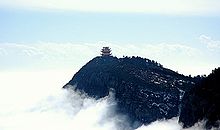 Emei Shan in Sichuan province
Emei Shan in Sichuan province
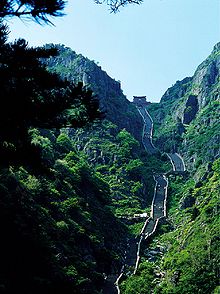 Tai Shan in Shandong Province
Tai Shan in Shandong Province
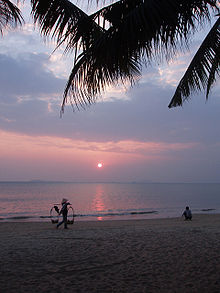 Sunset at Sanya Bay, Hainan
Sunset at Sanya Bay, Hainan
The most popular tourist attraction in China is the Great Wall of China. Also popular are the Forbidden City in Beijing, which was the center of Chinese Imperial power, and the Terracotta Army of the Qin Dynasty Emperor's mausoleum in Xi'an, a vast collection of full-size terracotta statues of Chinese Imperial soldiers and others.
See also: World Heritage Sites in China- The Bund, Shanghai, an elegant parade along the Huangpu River of colonial architecture juxtaposed with Shanghai's skyscrapers
- Caohai Lake, Guizhou, where many experience being punted along this shallow lake to see many of China's varied birdlife
- Changbai Mountains, an important nature reserve home to the rare Siberian Tiger
- Confucius Mansion, the site of this complex in Qufu, Shandong, was home to nearly eighty generations of the great sage's clan.
- Dazu Rock Carvings
- Forbidden City, Beijing, once the center of the 'Chinese imperial universe' and off-limits to the masses - now open to all
- Grand Canal of China
- Great Wall of China
- Guangzhou, Guangdong where the finest of the classic Cantonese breakfast dim sum is tried
- The Hanging Temple at Mount Heng is a temple clinging to a precipice and a series of grottoes containing a panoply of Buddhist statuary
- Yungang Grottoes, near Datong in Shanxi is a renowned Buddhist site.
- Hong Kong cityscape, especially the skyline of Hong Kong Island from Tsim Sha Tsui
- Harbin International Ice and Snow Sculpture Festival, Harbin, Heilongjiang, where extravagant and bizarre sculptures can be seen from life-size ice castles with rainbow lighting to fantastical snowy tableaux
- Jiuzhaigou Valley
- Leshan Giant Buddha, Sichuan the world's largest carved Buddha
- Lijiang River, Guangxi, where boat trips are taken to see the contorted peaks that have been immortalized in Chinese scroll paintings
- Longmen Grottoes, a parade of Buddhist figurines and reliefs, near Luoyang, Henan
- Mogao Caves, these 1,000-year-old man-made caves on the old Silk Road contain some of China's most impressive Buddhist heritage
- Mount Emei
- Mount Everest, highest mountain on Earth
- Mount Huang
- Mount Jiuhua
- Mount Lu
- Mount Qingcheng
- Mount Tai (or Tai Shan), Shandong, a holy peak home to immaculate temples and pavilions
- Mount Tianzhu
- Potala Palace, originally built by King Songtsän Gampo in 637 to greet his bride Princess Wencheng of the Tang Dynasty of China.
- Wudang Mountains
- Old Yalu Bridge, Dandong, Liaoning, this half-demolished bridge to North Korea is still an important relic of the Korean War.
- Sichuanese teahouses
- Silk Road, abandoned cities along this famous ancient trading route.
- Summer Palace
- Temple of Heaven
- Terracotta Army, in Shaanxi near Xi'an, the former ancient capital, these 2,200 year old life-size soldiers guard the tomb of China's first emperor.
- Three Gorges
- West Lake
- Xiamen, Fujian -- Gulangyu Island, famous for its colonial architecture
- Xishuangbanna Dai Autonomous Prefecture, Yunnan, home to one of China's most unique minorities - the Dai people
- Yabuli Ski Resort, Heilongjiang, the country's largest ski resort where many Chinese take their skiing holiday.
- Yangtze River, a river cruise down this river to see the awesome scenery and a wealth of historical sights
- Yellow river, one of the world's greatest rivers, offering a range of vistas, including the turbid Hukou Falls
Hainan
Hainan Island, sometimes referred to as "Hawaii of the Orient" is located off the south coast of mainland China. It hosts most of China's tropical resorts, and because of this, is extremely popular with mainland Chinese, as well as those from Hong Kong and nearby Asian countries. During the past few years, the Chinese government has heavily promoted Hainan Island as a world class resort with beaches and golf courses which are plentiful on Hainan Island. In addition, the ability to visit traditional Li and Miao cultural villages, hike among lush tropical rain forests and mountainsides, and visit significant cultural artifacts from long ago dynasties, has had a significant effect on tourism on the island. The Chinese and Hainan governments intend to continue to spend a great deal of money on infrastructure (December 2004 completion of Hainan to mainland China train; and, around the island expressways for cars and buses) and promotion of Hainan Island.
Tourist resources
Tourist resources in China can be divided into three main groups: natural sites, historical and cultural sites, and folk customs.
Natural sites
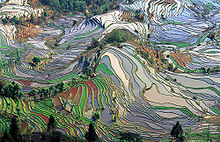 The terraced rice paddies of Yuanyang County, Yunnan
The terraced rice paddies of Yuanyang County, Yunnan
China's mountains, lakes, valleys, caves and waterfalls:
Mount Tai in the east, Mount Hengshan in the south, Mount Hua in the west, Mount Hengshan in the north, and Mount Song in the center of China have been called the Five Sacred Mountains since antiquity. Mount Taishan, which snakes through central Shandong Province, is admired by Chinese as paramount among them. Another mountain celebrated for its beauty is Mount Huang in southern Anhui Province, known for its graceful pines, unusual rocks, cloud seas and hot springs.
Jiuzhaigou, Huangguoshu Waterfall, and Guilin are all located in southwestern China. Jiuzhaigou in northern Sichuan Province is a beautiful "fairyland valley" running over 40 km through snow-covered mountains, lakes, waterfalls, and forest. The Huangguoshu Waterfalls in Guizhou Province are a group of waterfalls, 18 above-ground and four below, which can be heard from five km away. The Lijiang River in Guangxi Zhuang Autonomous Region winds its way through karst peaks for 82 km between Guilin and Yangshuo.
On the plateau in northern China are many spectacular lakes. The Tianchi (Heavenly Pool) in the Tianshan Mountains in Xinjiang Autonomous Region is 1,980 meters above sea level. This 105-m-deep lake is crystal clear, the high mountains surrounding it carpeted with green grass and colorful flowers.
Along the renowned Three Gorges of the Yangtze River are many scenic spots and historical sites; the Qutang Gorge is rugged and majestic, the Wu Gorge elegant, deep and secluded, the Xiling Gorge full of shoals and reefs and rolling water. The Lesser Three Gorges are lush with greenery, flanking water so clear you can see to the bottom. The Three Gorges Dam built here is China's biggest key hydro-power project.
Historical and cultural sites
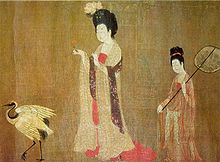 Beauties Wearing Flowers, by Zhou Fang, 8th century
Beauties Wearing Flowers, by Zhou Fang, 8th century
China's long history has left many cultural relics and the title of "China Top Tourist City" has gone to the first group of 54 cities. The Great Wall, a symbol of the Chinese nation, is also a prime example of historical sites that have become major tourist attractions. As the greatest defense-structure project in the history of human civilization, it dates back more than 2,000 years ago to the Spring and Autumn and the Warring States periods - huge in its scale and grandeur. There are more than ten sections of the Great Wall open to tourists, including the passes, blockhouses and beacon towers at Badaling in Beijing, Laolongtou in Hebei and Jiayuguan Pass in Gansu Province.
Grottoes filled with precious murals and sculptures are concentrated along the ancient Silk Road in Gansu Province. The best known are the Mogao Caves, a "treasure house of oriental art", with 492 caves with murals and statues on the cliff faces. There are 45,000 sq m of murals and over 2,100 colorful statues, all of high artistry. In the south, grotto art is represented in Sichuan Province by the Leshan Giant Buddha, carved into a cliff face. Seventy-one meters high and 28 meters wide, it is the largest sitting Buddha in stone, showing the carving skill of ancient craftsmen.
The Shaolin Temple in Henan Province, the birthplace of Chinese Zen Buddhism and famous for its Shaolin Kung Fu martial arts, dates back to 495 A.D. Here can be seen the Ming period Five-Hundred-Arhats Mural and Qing period Shaolin kungfu paintings. In central China's Hubei Province, beautiful Wudang Mountain, with 72 peaks in 30 km², is a sacred site of Taoism, which preserves one of China's most complete and largest-scale ancient Taoist architecture. In western Sichuan Province, Mount Emei, dotted with ancient Buddhist temples and structures, is one of China's four sacred Buddhist mountains。
Most of China's 101 cities classified as famous historical and cultural cities are over 1,000 years old. South of the Yangtze River, Suzhou and Hangzhou, long known as "paradise on earth", are crisscrossed with rivers, lakes, bridges, fields and villages, as beautiful as paintings. Today's well-preserved ancient cities includes that of Pingyao in central Shanxi Province, but was also the site of the Neolithic era Yangshao and Longshan cultures, 5,000 to 6,000 years ago. Ancient Lijiang in Yunnan Province is not only the center of Dongba culture of the Nakhi ethnic group but also a meeting place for the cultures of Han, Tibetan and Bai ethnicities. Built in the Song Dynasty, this city has many stone bridges, stone memorial arches and dwelling houses, which provide precious materials for architectural history and can be called a "living museum of ancient dwelling houses."
Folk customs
"March Street" celebrated by the Bai people in Dali, Yunnan Province, is associated with the Buddhist Goddess of Mercy suppressing a devil to help the Bai people. It became traditional to burn incense and offer sacrifices to commemorate her virtues every year and the festival has become a major annual gathering for Bai commercial, cultural and sports activities.
The Water-Sprinkling Festival of the Dai ethnic group in Xishuangbanna, Yunnan Province, is a lively occasion taking place in the spring. People chase and pour water (a symbol of good luck and happiness) over each other, among other activities such as dragon boat racing and peacock dance.
Lugu Lake between Sichuan and Yunnan provinces has become a tourist destination following the building of a new highway giving access to this area. The matriarchal society of the 30,000 local Mosuo people is noted for its "no marriage" traditions and is called the last women's kingdom on the earth. Mosuo women, local dugout canoes and undulating singing style are considered unique to Lugu Lake.
Tourist themes
The China National Tourism Administration promotes a tourist theme every year; 1992 was "Friendly Sightseeing Year." Then came "Landscape Tour", "Tour of Cultural Relics and Historical Sites", "Folk Customs Tour", "Holiday Tour", and "Ecological Environment Tour." From 2000 to 2004, the themes were "Century Year", "Sports and Health of China", "Folk Arts of China", and "Culinary Kingdom of China", and "Catch the Lifestyle."
The themes for 2005 are "China Travel Year" and "Beijing 2008 -- Welcome to China." In order to strengthen exchange and cooperation with the international tourism industry, the China National Travel Administration is planning a series of related events, including the Shanghai-hosted "2005 International Tourism Fair of China", the Beijing-hosted 2005 annual meeting of the Federation of Travel Agencies of France, and "the 2005 China-Australia Tourism Symposium." The China International Online Travel Fair 2005 held in March was comprehensive, providing a online exchange and trading platform between tour companies themselves and with their customers.
Tourist services
The fast development of China's transportation infrastructure provides wide-ranging travel for domestic and overseas tourists. Throughout China a great many hotels and restaurants have been constructed, renovated or expanded to satisfy all levels of requirement, and there are now 9,751 hotels with star ratings. All large or medium-sized cities and scenic spots have hotels with complete facilities and services for both domestic and international visitors.
China currently has 1,364 international travel agencies, 249 of them located in Beijing, Shanghai, Tianjin and Chongqing. On June 12, 2003, the China National Tourism Administration and the Ministry of Commerce jointly issued Interim Regulations on the Establishment of Foreign-funded or Wholly Foreign-owned Travel Agencies. On July 18, 2003, the China National Travel Administration approved the registration of JALPAK International (China) Ltd. as the first wholly foreign-owned travel company to enter China's tourist market. The company has started operations in Beijing, mainly handling Japanese tourism in China. On December 1, 2003, TUI China Travel Company was formally established in Beijing—the first overseas-controlled joint venture in China's tourism industry. The controlling party is Martin Buese China Limited and TUI Europe's largest travel group. Their Chinese partner is China Travel Service that has a network of over 300 local offices.
See also
- World Heritage Sites in China
- Public holidays in the People's Republic of China
- Archaeology of China
- Chinese cuisine
- Chinese tea
- Culture of China
- Geography of China
- History of China
- List of tourist attractions in Taiwan
- Tourist attractions of Beijing
- List of attractions in Shanghai
References
- ^ a b c Factbox: Basic facts about China's economy
- ^ [1]
- ^ chinadaily
- ^ Lew, Alan A. 1987. The History, Policies and Social Impact of International Tourism in the People’s Republic of China. Asian Profile 15(2)April:117 28.
- ^ World Tourism Organization UNTWO Tourism Barometer. June 2007 issue
- ^ "UNTWO World Tourism Barometer, Vol.5 No.2" (PDF). United Nations World Tourism Organization. June 2008. http://www.tourismroi.com/Content_Attachments/27670/File_633513750035785076.pdf. Retrieved 2008-10-15.
- ^ Third International Forum on Chinese Outbound Tourism, (2007)
- ^ a b The Chinese Outbound Tourism Market: New ETC/UNWTO study to be launched in March 2007
- ^ Lew, A.A. 2000. China: A Growth Engine for Asian Tourism. In C. Michael Hall and Stephen Page, eds., Tourism in South and South East Asia: Issues and Cases, pp. 268-85. (Oxford: Butterworth-Heinemann).
 This article incorporates public domain material from websites or documents of the Library of Congress Country Studies.[2]
This article incorporates public domain material from websites or documents of the Library of Congress Country Studies.[2]External links
- China travel guide from Wikitravel
- China National Tourist Office (CNTO)
- China National Tourism Administration (CNTA)
- Health Information for Travelers to China U.S. Centers for Disease Control and Prevention (CDC).
- China Tourism Statistics
- The Phenomena of Collective Travel Magazine article on tourism in China
- Shanghai Travel Tips & Tours Guide The Official Shanghai Travel Website
- Guilin Tourism Organization The Official Guilin Travel Website
World Heritage Sites in China East Classical Gardens of Suzhou · Fujian Tulou · Lushan National Park · Mount Huang (Huangshan) · Mount Sanqing (Sanqingshan) · Mount Tai (Taishan) · Mount Wuyi (Wuyishan) · Temple and Cemetery of Confucius and Kong Family Mansion, Qufu · Ancient villages in Southern Anhui - Xidi and Hongcun · West Lake Cultural Landscape of Hangzhou
South Central Ancient Building Complex in the Wudang Mountains · Historic Centre of Macau · Kaiping Diaolou and Villages · Longmen Grottoes · Historic Monuments of Dengfeng, including the Shaolin Monastery and Gaocheng Observatory · Wulingyuan Scenic and Historic Interest Area · Yin Xu
Southwest Dazu Rock Carvings · Historic Ensemble of the Potala Palace, including the Jokhang and Norbulingka · Huanglong Scenic and Historic Interest Area · Jiuzhaigou Valley Scenic and Historic Interest Area · Old Town of Lijiang · Mount Emei Scenic Area, including Leshan Giant Buddha Scenic Area · Mount Qingcheng and the Dujiangyan Irrigation System · Sichuan Giant Panda Sanctuaries · Three Parallel Rivers of Yunnan Protected Areas
North Mount Wutai (Wutaishan) · Chengde Mountain Resort and its outlying temples including the Putuo Zongcheng Temple, Xumi Fushou Temple and the Puning Temple · Imperial Palaces of the Ming and Qing Dynasties in Beijing and Shenyang · Peking Man Site at Zhoukoudian · Ancient City of Pingyao · Summer Palace, an Imperial Garden in Beijing · Temple of Heaven: an Imperial Sacrificial Altar in Beijing · Yungang Grottoes
Northeast Capital Cities and Tombs of the Ancient Koguryo Kingdom · Imperial Palaces of the Ming and Qing Dynasties in Beijing and Shenyang
Northwest Multiple regions  People's Republic of China topics
People's Republic of China topicsHistory China (timeline) · Republic of China (1912–1949) · People's Republic of China · 1949-1976 · 1976-1989 · 1989-2002 · since 2002 · Years in the People's Republic of ChinaGeography · Natural environment Overviews Regions Terrain Bays · Canyons · Caves · Deserts · Grasslands · Hills · Islands · Mountains (ranges · passes) · Peninsulas · Northeast / North / Central Plains · Valleys · VolcanoesWater Seas Reserves Wildlife Fauna · FloraGovernment · Politics · Economy Government
and politicsConstitution · National People's Congress · President · Vice President
State Council (Premier · Vice Premier) · Civil service · Military (People's Liberation Army) · Political parties (Communist Party) · Elections · Education (universities) · National security · Foreign relations · Public health · Food safety (incidents) · Social welfare · Water supply and sanitationAdministrative
divisionsProvince level subdivisions · Cities · Baseline islands ·
Border crossingsLaw Economy History · Historical GDP · Reform · Finance · Banking (Central bank) · Currency · Agriculture · Energy · Technological and industrial history · Science and technology · Transport · Ports and harbors · Communications · Special Economic Zones (SEZs) · Foreign aid · Standard of living · PovertyPeople · Culture People Society Culture Art · Cinema · Cuisine · Literature · Media · Newspapers · Music · Philosophy · Tourism · Sports · Martial arts · Variety arts · Tea culture · Smoking · Television · Public holidays · World Heritage Sites · Archaeology · Parks · Gardens · Libraries · ArchivesOther topics Tourism in Asia Sovereign
states- Afghanistan
- Armenia
- Azerbaijan
- Bahrain
- Bangladesh
- Bhutan
- Brunei
- Burma (Myanmar)
- Cambodia
- People's Republic of China
- Cyprus
- East Timor (Timor-Leste)
- Egypt
- Georgia
- India
- Indonesia
- Iran
- Iraq
- Israel
- Japan
- Jordan
- Kazakhstan
- North Korea
- South Korea
- Kuwait
- Kyrgyzstan
- Laos
- Lebanon
- Malaysia
- Maldives
- Mongolia
- Nepal
- Oman
- Pakistan
- Philippines
- Qatar
- Russia
- Saudi Arabia
- Singapore
- Sri Lanka
- Syria
- Tajikistan
- Thailand
- Turkey
- Turkmenistan
- United Arab Emirates
- Uzbekistan
- Vietnam
- Yemen
States with limited
recognition- Abkhazia
- Nagorno-Karabakh
- Northern Cyprus
- Palestine
- Republic of China (Taiwan)
- South Ossetia
Dependencies and
other territoriesCategories:- Tourism in China
- Industry in China
Wikimedia Foundation. 2010.


